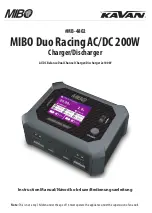
10
2.3.6. Synchronised parallel operation
Several chargers can be synchronised with the CAN interface. This is achieved by simply interconnecting the chargers with
RJ45 UTP cables (bus terminators needed, see section 2.3.5).
The paralleled chargers must have identical DIP switch and rotary switch settings .
A mix of Skylla-i 100A and 80A chargers can be paralleled.
Two output and three output chargers cannot be paralleled with each other.
The shore current limit of the parallel charger group can be set with the Skylla-i control panel. The current limit as shown on the
panel is the shore current of the group.
The output current of one charger may differ from another charger although connected in parallel.
If one charger from the parallel connected chargers is disconnected, the other charger(s) will blink the "ON" LED every three
seconds.
In case of using remote sensors (voltage and/or temperature), the remote sensor needs to be connected to one of the parallel
operating chargers. All other chargers will share the information via the CAN interface. The green LED in the charger with the
sensor connected to it, will be lit continuously, the other chargers will blink the corresponding LED.
In case of synchronized parallel operation the LED “ON” will blink every 3 seconds on all paralleled units.
2.3.7 Connecting the mains (see fig 4)
1. Check if the battery is connected to the charger.
2. Remove the front of the battery charger to access the AC input connector.
3. Connect the mains PE cable (green/yellow) to the AC input connector, terminal PE, located on the circuit board, see Figure
4. Connect the mains neutral cable (blue) to the AC input connector terminal N.
5. Connect the mains line cable (brown) to the AC input connector terminal L.
6.
Select the correct battery charge curve before applying AC power (see section 3).
Figure 6 Mains cable connection
3. CONTROL AND ADJUSTMENT
When the charger is installed correctly and before mains power is applied, the charger should be set up to suit the battery
connected.
Note about the models with three outputs: all settings are applied to the three outputs simultaneously
Figure 7 Internal controls and connections
For this purpose, the control board is fitted with a number of switches and connectors to facilitate the user with the following
options:
1. Rotary switch for choice of battery type.
2. Dip switch for setting various options.
3. Fine tuning of current and voltage for position 8 of the rotary switch.
4. CAN bus connection (RJ45).
5. Indicators for correct connection of voltage and temperature sensors.
6. Connection block for external sensors, switch and relay.
1
2
3
4
5
6
Summary of Contents for Skylla-i 24/100 (1+1)
Page 1: ...Manual EN Appendix Skylla i 24 80 1 1 24 80 3 24 100 1 1 24 100 3 ...
Page 2: ......
Page 4: ...4 ...
Page 17: ...1 EN Appendix Appendix A Dimensions ...





































